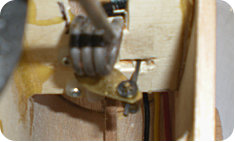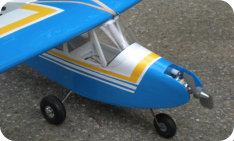

Swanky Doodle—Keith Laumer Tribute Build







.
Fuselage Sides and Elevator
Fuselage sides are constructed with
3/16” sq sticks. Horizontal stabilizer
shown with elevator for R/C control.
Stringers had to be wet and coaxed to
make the lower fuselage bend.


R/C Aircraft Insight From Low Altitude

John W. Blossick
Tail Slide Haven
johnb@tslidehaven.com
August 2020
Fuselage Front
Bulkhead for aft cabin was added for
strength. Original plan didn’t have the
bulkhead. Hole is to save weight and it
looks kind of cool. Interior was painted
to match covering. Cabin struts are
3/16 ply.

Fuselage Bottom
A bottom hatch is needed for battery
and servo access. The wing platform
makes top access impossible. Nose
gear compartment will be permanently
sealed..

Fuselage
3/16” sq stringers were used for
fuselage and Sullivan 2-56 Nylon Semi
flexible Gold-N-Rods are routed and
used for control.

Top Right Wing
D type wing with polyhedral tips and rib
cap strips. Center reinforcement spar
and sheeting holds both wing halves
together.


Empennage
3/16 balsa was used for construction.
Rudder and elevator were cut out for
control. Holes were drilled to save
weight.

Rudder and Pushrod Exit
I decided to extend the rudder to the
bottom of the fuselage. It made
control hookup much easier and
should be plenty big enough.

Nose Wheel Steering
Nose gear was fabricated from 1/8 “
wire and a brass control arm
soldered to the gear for control.

Bottom Right Wing
Sheeting for the wing bottom was
not required according to the
airplane plan.

From Ketih Laumer’s build article:
“How would you like to see a sleek realistic
model with a swept-rudder, low dihedral
wing and brilliant paint job parked on the
runway with the motor howling? Released, it
scoots forward for a 15 to 20 feet run before
lifting in a screaming climb, a tight-banked
acceleration that stresses the wing almost to
the folding point; then as the power cuts, a
perfect follow-through, from any attitude, without a stall, to a fast flat glide into a no-
bounce landing on grass or pavement!”
“If that’s your idea of sport flying let’s get started building Swanky Doodle.”+-+ Okay! I’m in! I’m ready to build one! Ever since writing the Classic Corner article about Keith Laumer, I wanted to build a tribute airplane using one of Keith’s designs. I finally chose the Swanky Doodle. The original airplane plan has a 34”wing span. I wanted a larger aircraft so I scaled it up 141%, which now gives the Swanky a 46” wingspan and a considerably larger fuselage. Also, some of the wood sizes were altered or changed to withstand the stress of the larger airframe. Virtually all of Keith’s free flight designs can be converted to R/C. Each one presents different engineering problems when outfitting with electrical power and R/C—but that’s part of the fun! I’m assuming those wishing to tackle a project like this will be an experienced builder so a step by step won’t be necessary. Wing construction is a flat bottomed polyhedral D tube and the fuselage is simple stick construction. Lets go!




Find The Best R/C
Engine Deals



Covering
Ultracote sky blue, cub yellow,
and white were used for covering.
“56’ is the year the Swanky was
designed. Keith would number his
models in order as he built them.

Top View
Lettering and numbers were
made using an ink-jet printer and
clear decal paper from
EXPERTS-CHOICE™ DECAL
FILM SHEETS

Power System
EMAX.BL2215/25 motor, 20A
SBEC, with 1300mAh 35c
battery—which was about the
largest battery that would fit..

That about wraps it
up for the Swanky
Doodle tribute build
honoring Keith
Laumer. I’ll post an
update on the test
flights after I fly
later on this week.
In the mean time, I
think I’ll read another one of Keith’s books.
Special thanks to Outerzone for supplying the plans that made this build possible.
Tail Slide Haven
Designs




tslidehaven.com
Top of Page








